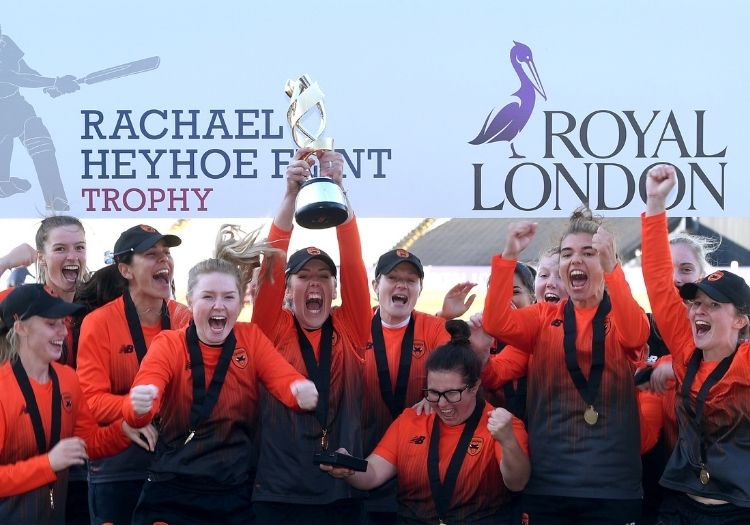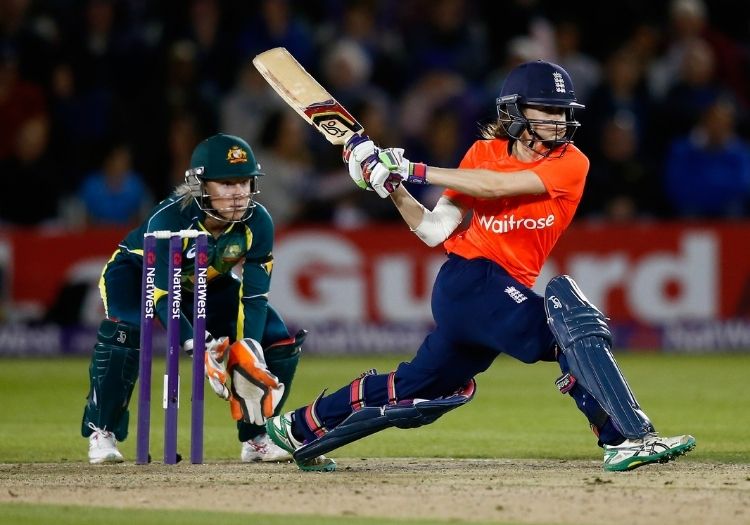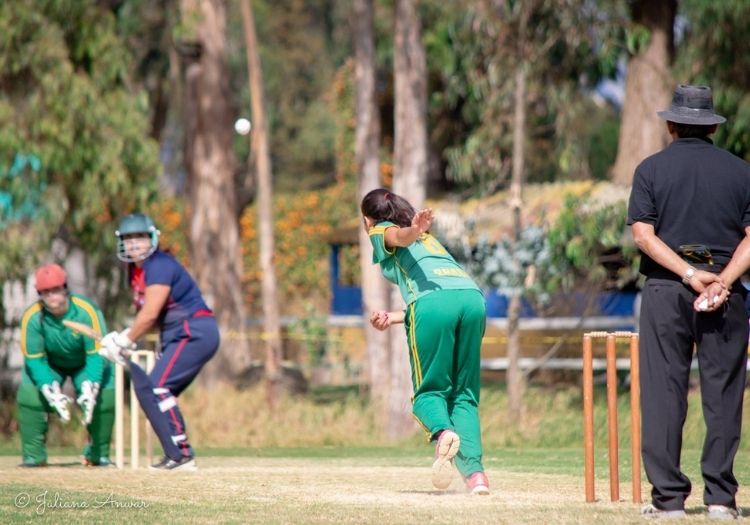NICK FRIEND: Greenway can empathise with this first tranche of domestic contract-holders, having been part of England's primary group of international pros. She discusses the pressure of social media and learning to deal with increased scrutiny

These next few weeks and months will provide a different challenge for 41 women in the domestic game. Last June, 25 female cricketers were handed retainer deals ahead of the truncated, Covid-delayed campaign as an initial commitment to their talent and as a precursor to the future, before 16 were added once summer had become autumn.
Coming up to a year on, they have enjoyed the benefits of a first winter as full-time professionals, not having to worry about how to squeeze training sessions around other commitments. The gains, by several accounts, have been excitingly noticeable: players hitting the ball harder, bowling faster, generally asserting the kind of leadership and dominance that will invariably develop over time as a consequence of this gradual professionalisation.
The proof, though, will be in the pudding. Once the action is underway, the currency becomes runs and wickets. In some cases, there will be whispers of higher honours. For others, who start the season slowly and struggle for their best form, scrutiny will not be far away.
Lydia Greenway can empathise with this first tranche of contract-holders; for there was a time when she was in the same boat as part of England’s primary batch of international pros. She recalls the exact moment it hit her, sitting indoors at Loughborough as she listened to a presentation delivered by Clare Connor, the captain on her England debut in 2003, but by then an influential administrative figure.
VISIT THE WOMEN'S REGIONAL HUB
“She took us through this PowerPoint, which basically outlined what the reality was,” says Greenway. “We were going to be the first full-time professional cricketers in England. I just remember we were all looking around the room and our jaws were on the floor, thinking that this was amazing. After that point, the reality set in a bit – suddenly there was a bigger expectation from the media and from the fans.”
Four months later, England were beaten in a Test by India: “We had a bit of a shocker,” she laughs. Greenway brings up the memory of that game because it acted as a realisation of what she had entered into.
She explains: “Really, that was the reality of being a professional cricketer – that is now your job. That’s one of the challenges that we came through – the added expectation. Also, it’s how you manage being a professional player: you’re not always doing something physical every single day; it’s managing your mind and managing your body and giving yourself that time to rest. Part of that is how you manage the scrutiny.”

Greenway represented England for more than a decade
Greenway remembers a recent conversation about the present day with Mark Lane, England’s coach through their all-conquering 2009 – a year that brought glory in the World Cup, World T20 and Women’s Ashes. “He just said that these players now have to earn their money through scoring runs and taking wickets.”
Which brings her to the poisoned chalice of social media. She was a reluctant, belated joiner, baffled by “the idea that people were interested in what we had to say”.
She has been heartened by the work of Charlotte Edwards, another of her former England captains and now multitasking as president of the Professional Cricketers’ Association and head coach of Southern Vipers. In two recent interviews on this website with Mark O’Leary and Trevor Griffin – head coaches at Western Storm and Sunrisers respectively – both men also praised the PCA for talking its newest members through some of the difficulties and dilemmas they are likely to face with their new status.
The Trevor Griffin Way
“One thing that she wants to do is an education around social media,” says Greenway. “I think as a young player coming through, from a peer pressure point of view, it’s a case of: ‘Oh, you have to be on this. You have to be engaging with everyone.’
“But that isn’t always the right thing for everyone – for some players, they might prefer to turn their phone off for the whole of the Rachael Heyhoe Flint Trophy and just concentrate on what they’re doing. I think that is a big challenge for players these days and I think it is something that I think they will need support on.
“I think you have to be pretty well-grounded to deal with the highs and lows of social media. I think you also have to be very honest with yourself. It’s very easy to get confirmation from social media – if you had a great game, people are going to be blowing smoke up you. But at the same time, you have to be really level-headed when things aren’t going so well.

41 women are now signed onto professional domestic contracts
“People are going to be scrutinising you and probably saying some not very nice things, so actually you have to be strong enough as a player mentally to understand and be very honest with yourself and know where you’re at with your performances.
“I think it’s very much a case as a player of having good people around you and being very grounded to deal with social media. Otherwise, you’re reliant on that as to whether you’re in a good mood or a bad mood and you’re constantly searching for that next hit of endorphins that you get when you get a nice message on Twitter. That’s where I think the education part is so important for the players.
“You have to have a handful of people. For some players, it might just be their family members. For others, it will be their one-to-one coach or maybe a good friend in their team. It’s about knowing who those people are.
“Professional sport can be quite brutal because sometimes you do just have a bad run of form. I suppose it’s about trying to manage your mind in a way that makes you focus on those positive outcomes rather than the ‘what ifs’. I think that’s one of the hardest things as a sportsperson, trying to block all of that out and not engage too much in those negative thoughts. But it’s easily done because the consequences now are much greater. For a lot of these girls, they’re on their first-ever contracts and they want to stay on them for as long as they can.”
Mark O'Leary is all about the player
As for the perceived significance of utilising social media to grow a personal brand or attract sponsorship and endorsements, Greenway believes that those fillips will come as “by-products” of on-field performances. “So, it’s having that understanding as well that, yes, the platforms are great, but you will only have a good amount of success through social media if you’re doing your job on the field.”
The former England batsman has witnessed that positivity herself in recent days in the reaction to the launch of the Girls Cricket Club, her latest initiative aimed at bringing more women into the sport, having previously established Cricket for Girls.
The objective is pleasingly straightforward: to accelerate the growth of the game around the world in areas otherwise not exposed to women’s cricket through sharing knowledge, resources and opportunities across an online platform and in face-to-face coaching. It will launch on June 1 through a Zoom-driven skills session with Heather Knight, having also signed up an advisory board of influential women across cricket from the United Kingdom, Ireland, New Zealand and – perhaps most intriguingly – Brazil.
Girls Cricket Club is here!
— Girls Cricket Club (@GirlsCricketC) May 24, 2021
Founded by England cricket legend @lydiagreenway, Girls Cricket Club is a global platform built by girls, for girls, to provide female specific resources and equal opportunities to play the game we love 🙌
Find out more here https://t.co/748T63LiXc pic.twitter.com/DfHqPsT1GU
And so, while Jenny Gunn and Tash Farrant have both represented England, the name of Brazil captain Roberta Moretti Avery stands out as a representative of what Greenway wants to achieve. Brazil announced at the beginning of 2020 that they were rolling out a raft of central contracts to their women’s squad, while Argentina also have a thriving women’s game in a part of the world rarely thought of with cricket in mind.
South America, then, is just one example of where Greenway wants to make an impact, with women and girls globally able to tune in to learn from Knight. “The good thing that I see in schools’ cricket all the time with girls’ programmes is that they’re not tarnished with the tradition and the expectation of what their journey has to look like,” she explains, highlighting a major deviation from the men’s game, where a status quo at the top of the sport has long-since existed.
“When we work with teachers and they ask us about formats of cricket and things like that, we pretty much a pathway for them – in school cricket, our recommendation is that the longest format the girls should be playing is T20 cricket because outside of school they have got the opportunity to play the longer formats of the game.”
She adds: “Depending on your location and if you’re a female and specifically a young girl, you might have a lot of opportunity to play cricket, but you also might not. So, there are some really strong areas where the opportunity to play girls’ cricket is brilliant – you can play in girls’ teams, women’s softball teams, women’s hardball teams and those sorts of things.
“But there are still lots of areas and pockets where you might have an isolated girl or handful of girls on their own who just don’t know what it’s like to have that amazing experience of what it’s like to be part of something special at a cricket club or a girls’ team in their school. Really, what the Girls Cricket Club wants to do is scoop up all of those girls, as well as the existing girls who have lots of opportunity, and just create that community.”

Brazil handed central contracts to their women's team at the start of 2020 (Image: Cricket Brasil)
For a project keen to work alongside governing bodies and complement existing ventures, in the short term that includes pushing women and girls towards a busy summer calendar for English cricket, beginning with the Rachael Heyhoe Flint Trophy but also featuring inaugural editions of the Regional T20 and The Hundred, as well as international series for England against India and New Zealand.
“A lot of the people that we already work with don’t always know exactly what’s going on in the women’s game in terms of what they can go to see and where they can watch it,” says Greenway. “I think it’s just about giving the girls the opportunity to know who they can watch.”
Among their options are Sophie Luff and Georgia Adams, captains and rivals in the revamped regional structure with Western Storm and Southern Vipers.
Meet Michaela Kirk, the South African starlet hoping to light up the East Midlands
When the overhaul was first announced, much of the subsequent talk focused on what it meant for the next generations of teenage girls and would-be pros. But in Luff and Adams, both now domestically contracted, the flag is being flown for the stalwarts of the county circuit.
“I think they are a great example of the sort of bottleneck that has now been taken away and has now given players like them the opportunity to play cricket as a job,” Greenway reflects. “In the past, if you wanted to be a professional cricketer, you were going to have to play for England. Whereas now, for players like that, they want to still be playing cricket, but they’d never had the opportunity. If these regional contracts hadn’t come in, we might have lost them. To still have those two involved is brilliant.
“It’s interesting to hear Georgia Adams speak; she now talks about managing her expectations. For her, I think she very much felt that if she was going to be successful, then she had to play for England. But for her now, success now might just be about being one of the captains in the competition who leads her team to victory and, with her own performances, being one of the best domestic players. We see that in the men’s game: people can be so successful at domestic level and it doesn’t have to be just at international level.”